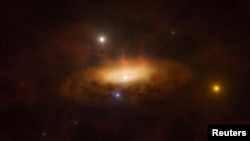Space researchers have observed a big increase in energy at the center of a distant galaxy caused by a very large black hole. They say the discovery could be meaningful for our own Milky Way galaxy.
In a recent research paper, space scientists said a huge black hole at the center of a galaxy called SDSS1335+0728 brightened by a large amount in several wavelengths of light.
A black hole is a collapsed star or group of stars whose gravity is so great even light cannot escape.
The European Southern Observatory (or ESO) in Germany announced the discovery on June 18.
One explanation for the brightening of SDSS1335+0728 is that the black hole at its center is just “awakening.” That means it is bringing in nearby material, which causes a huge release of energy.
Earth-based and orbiting telescopes were used to make observations of the galaxy. It is about 360 million light-years from Earth in the constellation of Virgo. A light year is the distance light travels in one year.
The black hole in the distant galaxy has the same mass as about one million suns. Because it is so massive, the black hole captures stars and any other material around it. This material forms a structure called an “accretion disk” around the mouth of the black hole. The matter there reaches an extremely high temperature and can outshine the galaxy containing it.
Scientists call this an “active galactic nucleus.”
Lorena Hernandez Garcia is with the University of Valparaiso in Chile and was a co-writer of the study. She said sometimes black holes shoot jets of high-energy particles into space, but none has been identified in this case.
Paula Sanchez Saez is an astrophysicist with the ESO and was the lead writer of the report. She said this kind of galaxy nucleus releases huge amounts of energy including radio waves and gamma rays. She also said the centers of galaxies such as these “are considered the most luminous objects in the universe.”
The change in the luminosity of the galactic center was first identified in 2019. It has been increasing since then.
But exactly why this galaxy has become activated is unclear. “At the moment, we do not know,” Sanchez said.
“It could be a natural process of the galaxy,” Hernandez said adding, “We know that a galaxy passes through different phases of activity and non-activity during its lifetime.”
The researchers say the latest discovery might be the awakening of a galactic nucleus or it might be a new kind of galactic event.
Scientists say there is a huge black hole at the center of the Milky Way galaxy. It is called Sagittarius A*. It is currently considered dormant, or asleep. But that could change.
Hernandez said, because it is 26,000 light-years away, such an event would likely not affect Earth. “…if it activates, we would not notice because we are very far from the center,” Hernandez noted.
I’m Mario Ritter, Jr.
Will Dunham reported this story for Reuters. Mario Ritter adapted this report for VOA Learning English with additional primary sources.
________________________________________________
Words in This Story
galaxy –n. a huge grouping of stars, gas and dust
disk –n. a round, flat form
nucleus –n. the center of a cell, atom or galaxy
luminous –adj. something that is bright because it shines
phase –n. one of several states of a thing that can change with time
We want to hear from you.
Our comment policy is here.











Forum